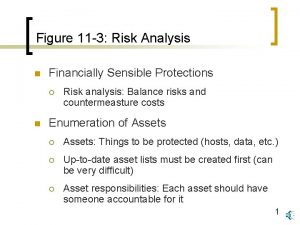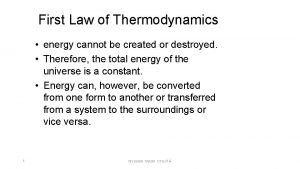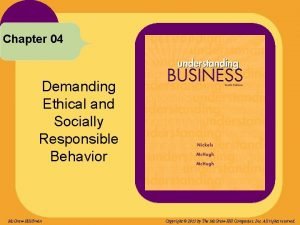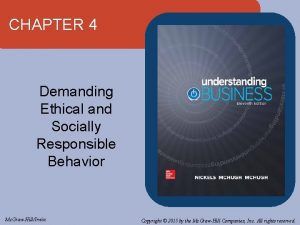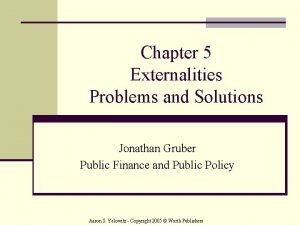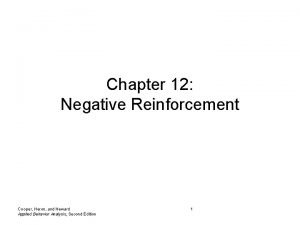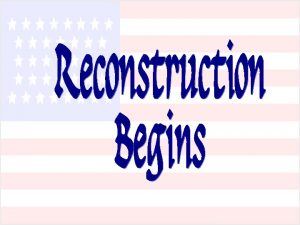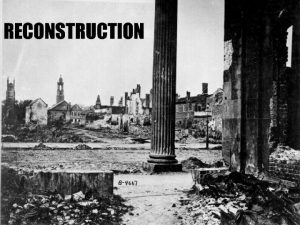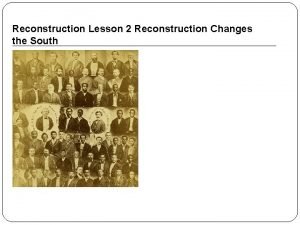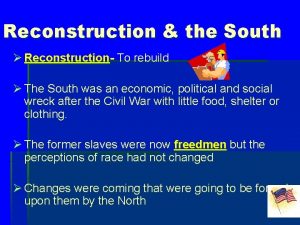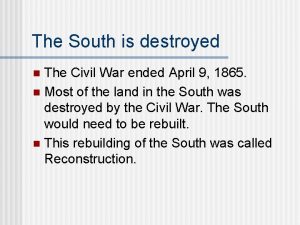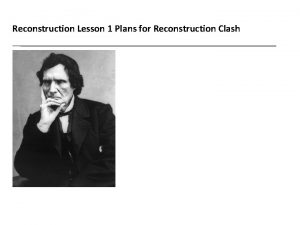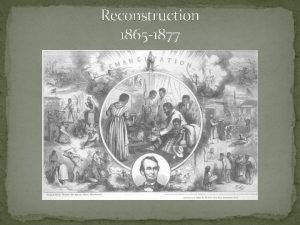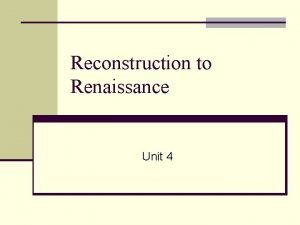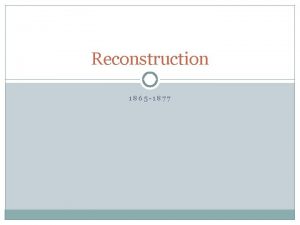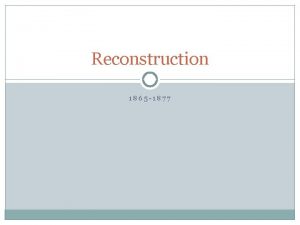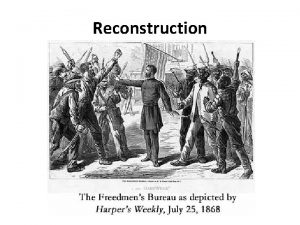Reconstruction Reconstruction South was financially socially politically destroyed




























- Slides: 28

Reconstruction

Reconstruction South was financially, socially, politically destroyed by the Civil War Reconstruction was the period to rebuild the South and readmit the Confederate states back into the Union ◦ Lincoln’s plan sought to make reconstruction as easy as possible to reduce hostilities ◦ Also known as 10% Plan ◦ Lincoln (R) chose a TN (D) Johnson to help win election of 1864

Lincoln’s Assassination John Wilkes Booth – Confederate Sympathizer ◦ “Sic Semper Tyrannis” – “Thus Always to Tyrants” ◦ Sec of State Seward injured ◦ Johnson and Grant unhurt Johnson’s Reconstruction - Plan focused more on punishing former Confederate leaders, and wealthy elite ◦ Did not ensure basic rights for African Americans

A New Plan Radical Reconstruction – Sought to overhaul Southern culture politically, socially to protect freed slaves ◦ AKA Wade-Davis Bill ◦ Much more punitive to the South than Lincoln or Johnson’s Reconstruction plan ◦ Most Republicans in Congress = ABOLITIONIST!

Reconstruction Act of 1867 Confederacy was divided into 5 districts with a Union general in charge States had to rewrite their constitutions and include ◦ 14 th Amendment – Everyone born in the US is a citizen and has equal rights before the law ◦ 15 th Amendment – All men can vote

Freedmen’s Bureau Sought to help freed slaves ◦ Created schools ◦ Encouraged voting rights ◦ A few Confederate states elected black leaders Scalawags Southerners who supported Reconstruction Carpetbaggers Northerners who moved South to profit from Reconstruction

Part II

Andrew Johnson As President he constantly clashed with Republicans in Congress ◦ Vetoed numerous laws to punish South or help freedmen Johnson violated a law passed by Congress to limit his power and was charged with impeachment, ◦ Senate was 1 vote shy of removing him from office General Grant elected president in 1868

Civil Rights Act of 1875 Mirrored the 14 th Amendment ◦ Allowed government to fine states and individuals who denied people full equality ◦ Rarely enforced and eventually overturned by Supreme Court ◦ Congress cannot regulate prejudices of private citizens

Election of 1876 Rutherford B Hayes and Sam Tilden basically tied, with remaining votes being disputed ◦ Possible voter corruption Hayes is given the victory, with the promise to remove Union troops from the South ◦ Back room deal

Was Reconstruction a Failure? After 10 years many in the North grew tired of fighting with the South ◦ South had been divided into military districts and many wanted to finally bring soldiers home Radical Republican leaders began to die off, and younger leaders had different priorities Sharecropping / Tenant Farmers = Technically free, but permanently in debt to former master

Rights given to freedmen were slowly taken away ◦ Jim Crow Laws or Black Codes ◦ Unofficial laws that stripped blacks of their new freedoms ◦ Ku Klux Klan ◦ Disenfranchisement – loss of voting rights Plessy vs. Ferguson 1896 Supreme Court Case ◦ Legalized “Separate but Equal”



The Wild West

Turner’s Frontier Thesis

Encouraging Settlement Homestead Act – Families were given 160 acres, but had to stay and farm for 5 years and build a home; 21 or older Oklahoma Land Rush – Indian lands were given to settlers ◦ April 22, 1889 50, 000 people lined up at the OK border in order to stake a claim to land

Westward Expansion Mining - Few individuals got rich in the gold rushes; ended up working for mining companies Ranching – Cowboy culture, cattle drives, provided food for factories in the East ◦ The Morill Act – Land was given to states to build college to teach agriculture and mechanics

What About the Native Americans? Indian Removal Act of 1830 – Moved all nonassimilated Native Americans East of the Mississippi River ◦ Trail of Tears - 800 mile forced march led by US Army The Dawes Act of 1887 ◦ Indians were expected to adopt American ways or move to reservations ◦ “Americanization” or “Assimilation”

◦ Reservations were on worst land, and few promises for food / basics were kept ◦ Sitting Bull - Sioux ◦ Chief Joseph – Nez Perce ◦ Geronimo - Apache

Conflict over Land was seized for mining, ranching ◦ Sand Creek Massacre – US soldiers slaughter Indians for leaving their reservation ◦ Battle of Little Bighorn – Sitting Bull defeats General Custer “Last Stand” ◦ Wounded Knee Massacre – Men, Women, and children slaughtered for Little Bighorn ◦ Instilled fear in other Indian groups


Impact of the Railroads

Impact of the Railroads were needed to ship food from the West to the East ◦ Pacific Railway Act – Millions of acres to railroad companies for building tracks and telegraph lines 2 companies were charged to build a transcontinental railroad ◦ Met at Promontory Point, Utah; 1876


Effects of the Railroads Led to the creation of time zones ◦ Train schedules Chinese and Irish immigrants flooded into the US to work the railroad ◦ Extremely harsh life; Prejudiced attitudes Chinese Immigration Act of 1882 – Barred Chinese Immigration to the West Coast

Assimilation Americanization – Process where immigrants and native Americans adapted to white American culture ◦ English, Christianity, Clothing Styles, Values ◦ Fear that they would not assimilate ◦ Melting Pot – Encourage uniformity, similarities ◦ Salad Bowl – Celebrate our differences

 Elephant communication
Elephant communication How is space politically organized into states and nations?
How is space politically organized into states and nations? What is the name
What is the name Financially sensible
Financially sensible Who killed reconstruction
Who killed reconstruction Replacement of destroyed tissue by the same kind of cells
Replacement of destroyed tissue by the same kind of cells Forms of energy
Forms of energy How was the statue of zeus destroyed
How was the statue of zeus destroyed Which parts of tohirin’s house were destroyed?
Which parts of tohirin’s house were destroyed? Nubia conquered egypt
Nubia conquered egypt Energy can be created and destroyed
Energy can be created and destroyed The teacher punished his students for not doing homework
The teacher punished his students for not doing homework Destroyed verb 3
Destroyed verb 3 Energy cannot be created or destroyed
Energy cannot be created or destroyed Presuppositionalism destroyed
Presuppositionalism destroyed Bce
Bce Old south vs new south streetcar named desire
Old south vs new south streetcar named desire Ethics lg 1 shoes
Ethics lg 1 shoes Demanding ethical and socially responsible behavior
Demanding ethical and socially responsible behavior Social health means
Social health means Socially deprived child meaning
Socially deprived child meaning Chapter 2 socially responsive marketing
Chapter 2 socially responsive marketing Socially optimal level
Socially optimal level What is the socially optimal quantity
What is the socially optimal quantity Socially adept definition
Socially adept definition Negative reinforcement
Negative reinforcement Meaning of social adjustment
Meaning of social adjustment Socially mediated positive
Socially mediated positive What is the socially optimal quantity
What is the socially optimal quantity



